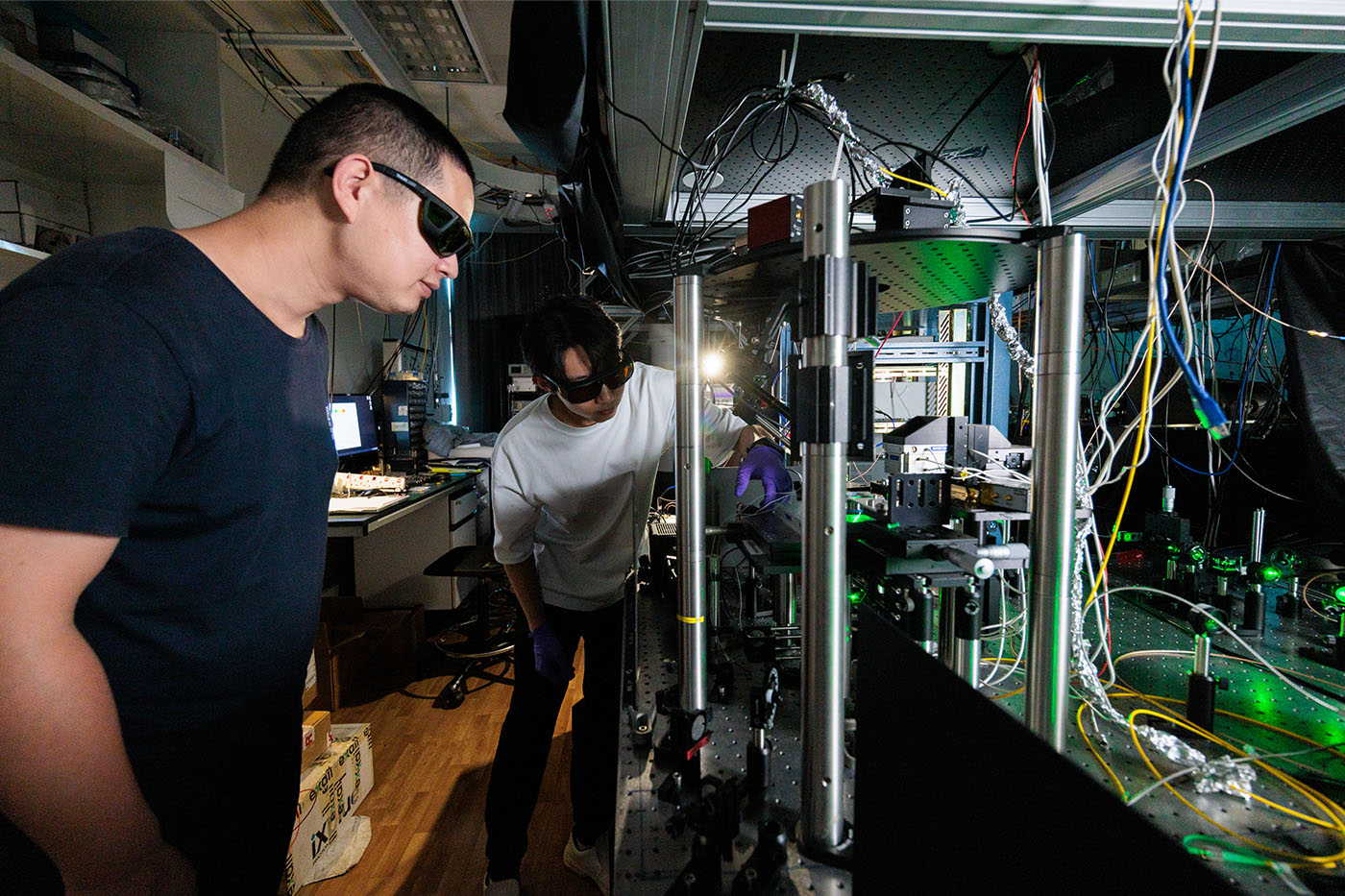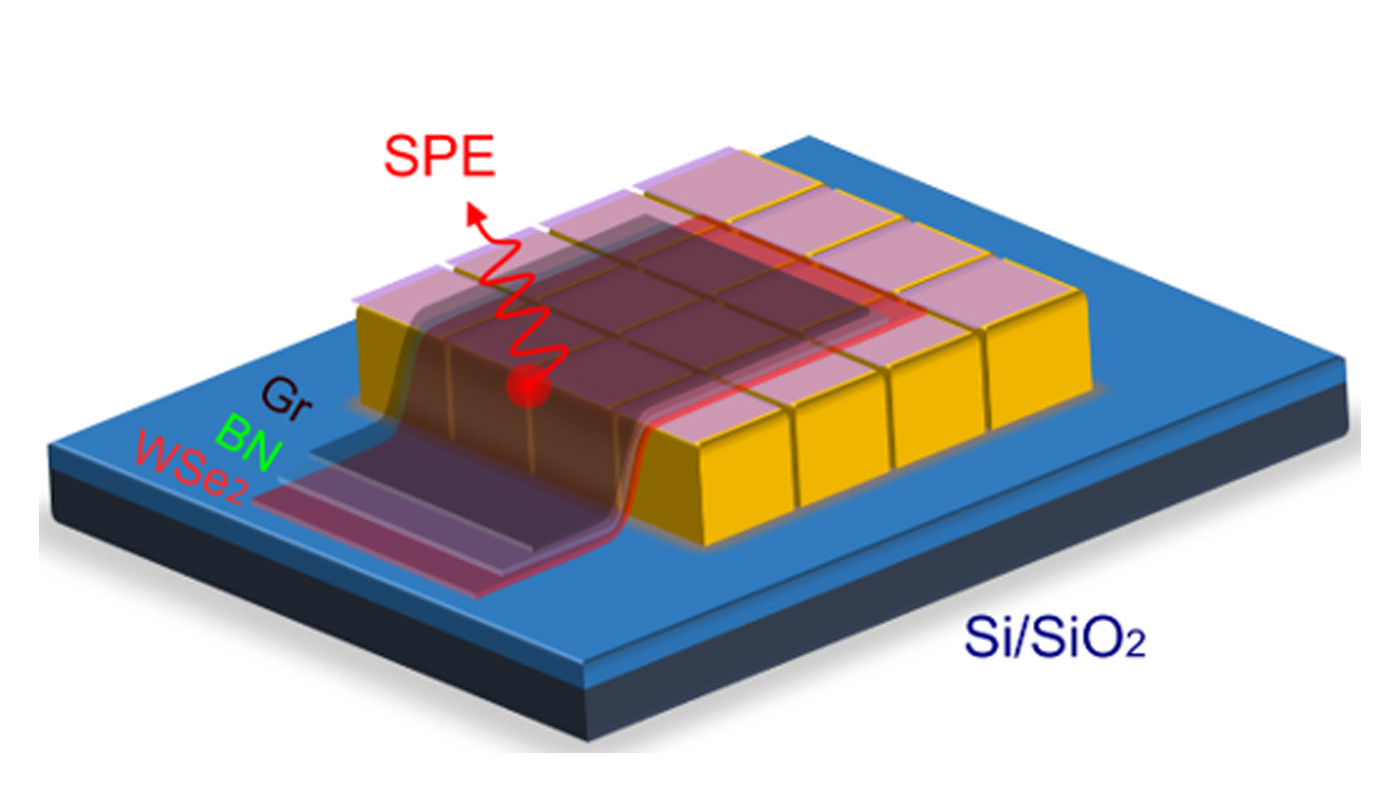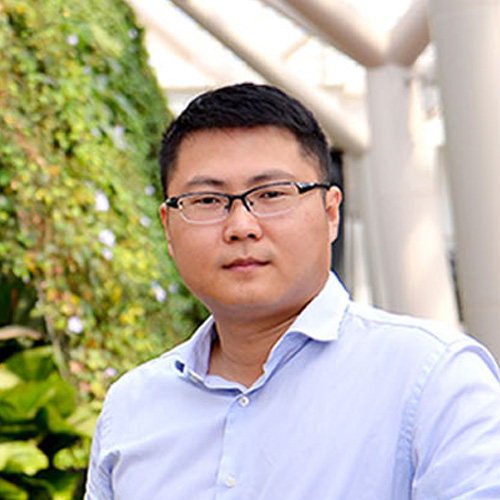Highlights
Novel solid-state device offers single photons on demand
 (Front) NTU Research Fellow Cai Hongbing with the group's experimental setup.
(Front) NTU Research Fellow Cai Hongbing with the group's experimental setup.
Quantum engineers long for a device that can reliably make single photons on demand. An international team of researchers led by CQT Principal Investigator Gao Weibo has come close with a single photon emitter made from two-dimensional materials. They report their results in Nature Photonics on 17 June 2024.
Single photon emitters are needed for quantum technologies such as photonic quantum computation and quantum communication. A good emitter will have high efficiency in two measures – high quantum efficiency, meaning the device emits a photon on demand, and high collection efficiency, meaning the emitted photon is easily collected and routed for application.
2D materials have always been promising for high collection efficiency because the photon emitter is at the surface of the device. Achieving high quantum efficiency was more challenging.
The team’s novel approach reached a quantum efficiency of 76.4% on average and more than 90% for some emitters, approaching what is known as ‘unity quantum efficiency’ of 100%. It is the first time near-unity has been achieved in 2D materials.
Weibo’s co-authors are his current and former group members at the Nanyang Technological University, Singapore (NTU), where he is currently a Professor and President's Chair Professor in Physics. Their collaborators are from A*STAR’s Institute of Materials Research and Engineering, University of Science and Technology of China, and Zhejiang University.
The researchers built their emitters using a 2D layer of the material tungsten diselenide, or WSe2, on top of an array of gold pillars. The WSe2 layer is just one atom thick.
Depleting charge for efficiency
To get a single photon from the 2D WSe2, the researchers first generate a ‘localised exciton’, a quasiparticle in an excited state, with a laser. As the exciton decays back to the ground state, it could undergo radiative or non-radiative decay. A photon is emitted only if the decay is radiative.
“Both processes happen with some probability,” says NTU Research Fellow Abdullah Rasmita, who is a co-first author of the paper with NTU Research Fellow Cai Hongbing. “If we can get the probability of non-radiative decay close to zero, we can reach near-unity efficiency.”
One main reason for non-radiative decay is the exciton interacting with positive and negative charges in the material. The researchers set out to minimise this effect using an approach known as ‘charge depletion’. The goal is to use an electric field to separate the exciton and the charges.
To do this, the researchers added two gates to their device that can apply a voltage. The gate voltage can do two things – produce an electric field in the device or add charge to the device, which is known as doping. The team’s novel dual-gate configuration allows them to change the electric field while keeping doping constant.
When they apply the electric field, the charges are driven away from the exciton, with the positive charges driven to the top gate and the negative charges driven to the bottom gate. The electrically neutral exciton is not moved by the field and so ends up separated from the charges in space. This suppresses non-radiative decay.
Path to near-unity
Simply making excitons in a layer of 2D WSe2 gives you single photon emitter with a quantum efficiency of 7.8% on average.
Earlier work by other groups had shown a way to enhance radiative decay, bringing the quantum efficiency to an average of 29.2. This is the layering of the WSe2 over metal ‘pillars’ that create a strain in the material. Weibo’s team fabricated a closely-packed nanogap array with a highly uniform gap width of 10 nm (10-8 m), putting the WSe2 on top.
 The team’s design for a single photon emitter has a layer of tungsten diselenide, WSe2, draped on top of gold ‘pillars’. Single photons are emitted from the nanogaps between the gold pillars when a laser excites the WSe2. Image credit: Nature Photonics
The team’s design for a single photon emitter has a layer of tungsten diselenide, WSe2, draped on top of gold ‘pillars’. Single photons are emitted from the nanogaps between the gold pillars when a laser excites the WSe2. Image credit: Nature Photonics
“This design tells us where the photon will be emitted from – the near gap between pillars,” says Abdullah. “Now, we just need quantum efficiency to know when the photon emits.”
The team added the charge depletion approach to suppress non-radiative decay, achieving an average of 76.4% quantum efficiency. Their demonstration is the first successful suppression of non-radiative decay of localised excitons in 2D materials.
The team sees a few possible directions for their work. One is to integrate their single photon emitter with photonic chips to make it more portable. Another direction is to generate the excitons electrically rather than optically with lasers. This would make the emitter cheaper and easier to mass fabricate.
Weibo's group is currently hiring research fellows and PhD students in quantum photonics and integrated photonics. Interested candidates can write directly to Weibo at: wbgao@ntu.edu.sg
Learn more
Related Stories
 | Quantum states mapped efficiently with overlapping measurements April 19 2023 |
 | Meet a CQTian: Gao Weibo July 20 2022 |
Future magnetic memory devices could rely on the quantum metric September 21 2023 |






